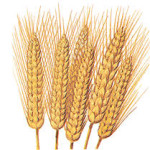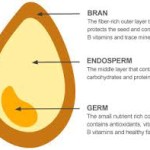Gluten, Wheat and Inflammation
By Dr. Cynthia Horner
Is all this talk about gluten and being gluten free just hype, or is there something healthy about reducing gluten in your diet?
Gluten is a protein in the kernel of the head of the wheat plant. There is another protein that doesn’t get as much press gliadin. These proteins are also found in some other grains but not to the extent that they are found in wheat. Wheat is a grass with a root, stem, and head
Many kernels are found in the head, and each kernel is made up of four parts, the husk, the bran, the germ, and the endosperm.
The outer most coating is called the husk, or chaff, and is unusable for most purposes. The bran, a protective coating around the kernel inside the husk similar to the paper like layer inside the shell of a nut, it is rich in nutrients, and is a source of valuable fiber. The germ is the part of the plant that reproduces when planted, and so it contains concentrated food to support new life, it is rich in vitamin E and the B vitamins niacin and thiamin. The endosperm is the soft inside portion of a kernel containing starch and proteins, including the proteins gluten and gliadin. 
Today’s wheat is not the same as it once was. Many of us were raised on white bread. I personally liked rolling my bread into little round dough balls when I was bored. Bread today is very different from the bread I ate as a kid; not that bread was made that great or healthy back then. Today the endosperm is larger creating more starch and more gluten and gliadin. Our bodies produce less digestive enzymes and less hydrochloric acid as we age making the breakdown of the tough proteins more taxing to the digestive system. The more ant-acids we take the more it taxes out gut.
Three things have caused wheat to change:
- Wheat has changed and adapted over the years all by itself. Every living thing must change and adapt to survive, wheat is no exception.
- In the last fifteen years scientists have grown different strains of wheat together to produce different kinds of wheat. This is called hybridization. Some new wheat makes great pizza dough (tough and stretchy), others make angel food cake (light and fluffy) and others make everything else in between. Mixing wheat varieties is different that mixing other plants because both ‘parent’ wheat varieties donate 46 chromosomes giving the new wheat 92 chromosomes therefore changing the plant. In comparison when a human sperm meets a human egg it donates 23, half of its 46 chromosomes and the egg also donates 23 chromosomes resulting in the developing life having 46 chromosomes just like its parents.
- Genetic modification of wheat is fairly new. Scientists have modified the genetic code of wheat to enable it to be resistant to a strong pesticide that kills everything it touches, but the GMO wheat. They have modified the genes of some wheat to produce its own pesticides to keep bug from eating and destroying it.
The journey from farm to your table
The planting and harvesting of wheat today is different from when I was a child and very different from ancient times. The wheat of ancient times made cruder, denser flour, it was not fluffy and fine like the flour we know. The crude, dense flour made tough, crumbly sometimes crunchy bread.
In the farming practices of today before wheat seeds are even planted in the ground they are treated with fungicides and insecticides (1). Many of these pesticides function as xenoestrogens, or psydo-estrogens, filling the estrogen receptors and creating havoc with hormone balance. Farmers also apply hormone-like substances, or “plant growth regulators,” to affect wheat characteristics such as germination time and strength of stalk. Some hormones are natural, meaning extracts from other plants, and some are synthetic. Cylorel is a common synthetic hormone applied to wheat (2).
Once grain is harvested it must be stored. The bins that store grain are sprayed with insecticide inside and out, to protect against critters and moths. More protectants are sprayed while the bins are filling, then added to the upper surface. The list of chemicals used includes chlorpxifos-methyl, Diatommceous earlbaccilus thoringlenissi, cy-fluthrix, malathion, and pyrethrums (3).
Grain is dried through a heat process; heating causes some denaturing of the proteins. After it is dried the processing begins with milling. Grains were originally milled by grinding them between large stones, the final product being 100% stone-ground whole wheat flour. It contained everything that was in the grain kernel, the bran, germ and endosperm. Without refrigeration or chemical preservatives, fresh stone-ground flour spoils quickly. The wheat-germ oil becomes rancid at about the same rate that milk becomes sour. Refrigeration of whole grain breads is necessary. To create bread that doesn’t need to be refrigerated and has a longer shelf life, modern technology applies faster, hotter, and more aggressive processing.
Today bread is processed with high-speed, steel roller mills that eject the germ and the bran. The resulting product is white flour containing only a fraction of the vitamins and minerals of the whole kernel. Even whole-wheat flour is compromised by the milling process with 400 degree heat, destroying the vitamins, especially E. Most flour is treated with dozens of dough conditioners and preservatives as well as partially hydrogenated vegetable oils. People become used to the mass produced, soft, and nutritional deficient breads and baked goods.
Eighty percent of the total nutrients in wheat including fiber are lost when the bran is removed. The lack of fiber in white bread and processed bread products constipates the bowel, inducing stagnation of wastes in the digestive tract and leads to development of unhealthy microorganisms like the fungus Candida Albicans which has the unique ability to change from yeast into a fungus. Once a fungus, it operates like other fungus such as athlete’s foot. It is strong and invasive and attaches itself to the intestinal wall as it attempts to become a permanent resident of internal organs. Normally it is kept at low levels in a healthy body by the friendly or good bacteria called microflora that also resides in the digestive tract as well as in other areas of the body.
Gluten Free – to be or not to be
Inflammation is a product of carbohydrate metabolism. To metabolize the starch in wheat glycation must occur. This is where carbohydrates team up with a fat or protein. Excessive glycation creates excessive oxidation. Our bodies’ have a way to handle oxidation (the production of free radicals) my making antioxidants, but around 35 years old we begin making less antioxidants, it takes its toll on us about
 10 years later creating inflammation and signs of aging. Oxidation creates inflammation that targets joints, brain, gut and blood vessels. Inflammation often is the cause of headaches,and digestive issues.
10 years later creating inflammation and signs of aging. Oxidation creates inflammation that targets joints, brain, gut and blood vessels. Inflammation often is the cause of headaches,and digestive issues.
So gluten and gliadin proteins can be the cause of health problems inflammation related. The average American diet is far too high in processed carbohydrates such as bread and pasta, leading to enzyme burn-out and creating inflammation. My advice is if you do not have obvious symptoms cut down rather than cut out processed wheat products and other processed carbohydrates such as bread, baked goods, cereals and pasta .